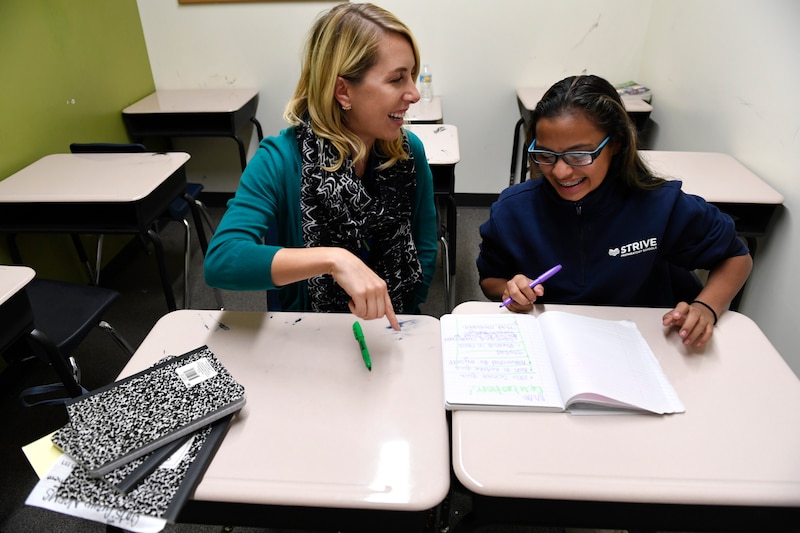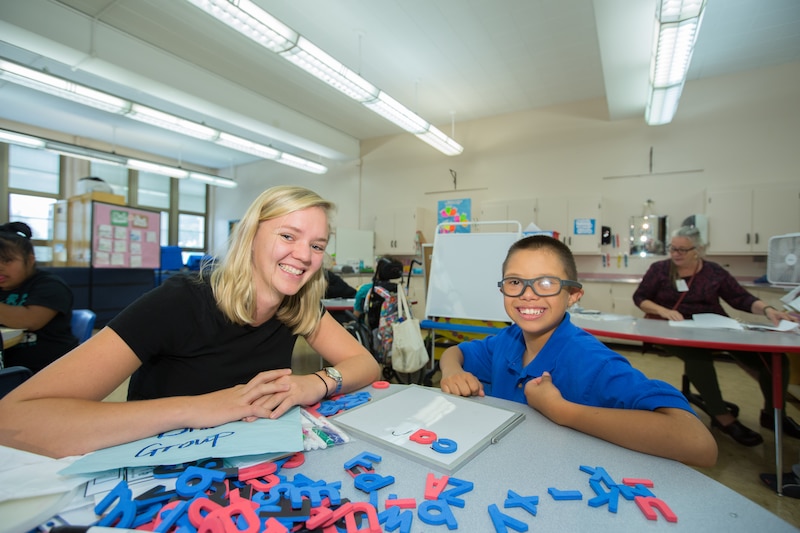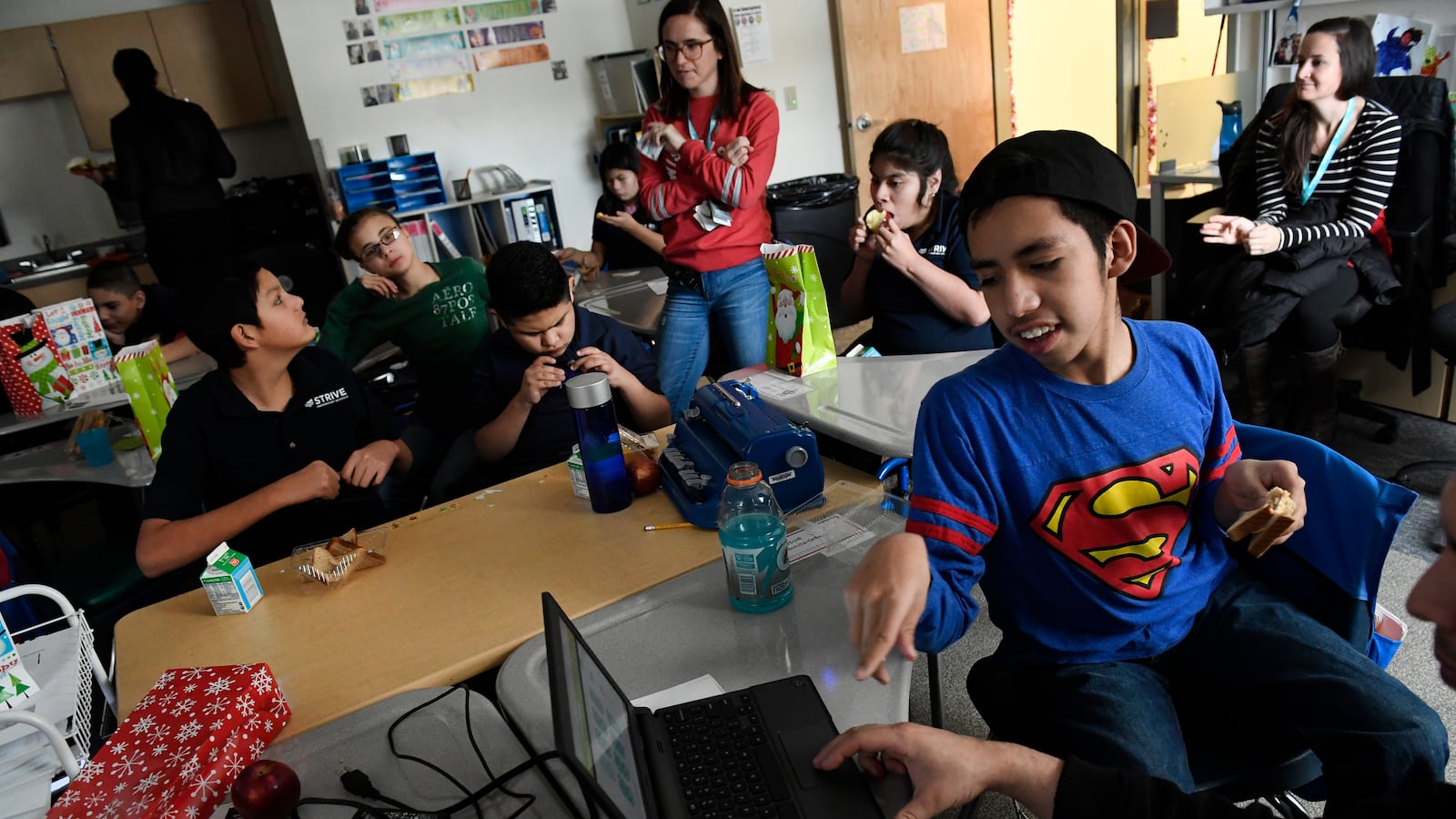When Josue Bonilla started at STRIVE Prep Federal, he spent a lot of time trying to earn happy-face stickers and string cheese. These were the rewards for sticking to his behavior plan.
At times, they seemed hopelessly out of reach. One day, Josue was caught playing with a lighter in the bathroom. Another day, he hit a teacher’s aide in the face.
Now, as the 13-year-old completes his second year in the middle school’s special education classroom — named “Wisconsin,” for teacher Wendi Sussman’s alma mater — Josue is off the behavior plan and spending 90 percent of his time on academics.
He is using words his teachers gave him for when a classmate with autism gets too close — “Please be outside my personal space” — and not getting physical. Twice a week he participates in a general-education gym class, where things feel safe and structured to him.
Students and their teachers make breakthroughs like Josue’s in schools across Denver and the country every day. But it’s remarkable at STRIVE because until a few years ago, the charter network, like many others, wasn’t focused on meeting the needs of students like Josue.
That changed in part because of an unusual effort by Denver Public Schools to get its charter schools to serve their fair share of high-needs students. It also changed because STRIVE embraced the new challenge, part of a broader “equity agenda” that includes other changes in enrollment and school practices.
“This is about creating the best system for public schools on behalf of communities,” said the network’s CEO, Chris Gibbons. “We believe that requires that charter schools be a part of a system of durable public institutions that are truly creating that value for a community. That is the right thing to do morally.”
Now, as the network seeks to grow again, it is seeking to prove that charter schools can sustain high test scores even when they educate students who bring many challenges — a result that’s proven elusive for others who have tried.
“STRIVE will almost surely be applauded if it has high scores,” said Kevin Welner, a researcher who heads an education research center at the University of Colorado at Boulder. “I don’t know if it’s going to be applauded if it’s going to be equitable.”
STRIVE began in 2006 with a single charter school in southwest Denver. Since then, it has grown into an 11-school network educating 3,500 students, most of them low-income and Latino.
The network offers families a straightforward proposition: We will offer your children safety, structure and preparation for college. Students wear uniforms, teachers command attention in the classroom, passing periods are expected to be quiet and orderly, and the school uses a battery of data to guide its thinking.
Gibbons traces the network’s equity agenda to 2009, when DPS Superintendent Tom Boasberg came to him with a request: Would STRIVE be willing to open a middle school in an existing district building as a “boundary school,” meaning it would be the default school for kids who live in that area?
The request put Denver at the forefront of a developing push to get charter schools to do the hard work of trying to work with existing communities, rather than just create new ones with a fresh slate. Within a couple of years, other operators were taking up the charge, including the Democracy Prep in New York City and those authorized by Tennessee’s Achievement School District, which was created to replace long-struggling neighborhood schools with better ones.
Chris Barbic, who led Tennessee’s turnaround district until 2015, said he sees STRIVE’s equity work as evidence of a maturing charter sector.
“If we are talking about wanting to transform a system and talk about ways to transform public education, we cannot say that honestly without saying then we are serving a broad range of students,” said Barbic, who when he resigned in 2015 called on charter operators to step up to turnaround work.
But at the time Boasberg approached Gibbons, few charter operators had taken the approach. Prior to his request, STRIVE — then known as West Denver Prep — had followed the charter school playbook of accepting students by lottery from anywhere in the district.
“That was a moment in our history when we really looked at our institutional values and decided to take a different course,” Gibbons said. “We had to ask ourselves: ‘As a neighborhood boundary school, are you going to serve all students?’ That was significant.”
When STRIVE Prep Lake opened in 2010, Gibbons said STRIVE set out to build a school that was “truly of the neighborhood, serving all kids.” That meant not only serving students with disabilities or students who do not know English, but also taking a stand about “backfill,” an issue that divides charter advocates. Some charter schools across the country do not replace students who leave, avoiding a potential drop in test scores and the disruption of adding new students. But STRIVE Prep Lake decided to take students at mid-year and in all grades.
That practice that has since spread to all STRIVE schools. The network does not participate in the district’s choice process for 12th grade, but does admit interested 12th grade students who can demonstrate they have enough credits.
It’s too early to gauge the academic impact, positive or negative, of STRIVE’s efforts to serve all students.
STRIVE did see its state test scores plummet in 2014 as it was in the midst of changing its practices. Although Gibbons never publicly cited the equity push when explaining about the low scores at the time, he now acknowledges that it likely had an impact.
“Our first class of sixth-graders was 100 kids and we finished with 55 eighth-graders two years later,” Gibbons said. “Now, we have 120 kids in sixth, seventh and eighth grades. That is going to lead to a different environment in terms of outcomes.”
Other returns are mixed. On state English and math tests, STRIVE special education students and English language learners typically lag behind the district for being at grade-level. But their “growth” scores are higher than those for students with special needs in district schools, meaning that STRIVE students are covering more ground each year.
By last year, Gibbons was ready to declare his commitment to the equity approach in a letter outlining STRIVE’s work.
“Please forgive the cynical perspective, but I increasingly fear that too many initiatives branded as school reform across our country are initiatives not to change the programs inside of schools, but rather initiatives to adjust the circumstances such that some students are encouraged to enter the school and others are encouraged to leave,” Gibbons wrote to the network’s staff, families and supporters. “Far too often, those encouraged to enter are those already on track to proficiency and those encouraged to leave are those students with the most significant needs.
“At STRIVE Prep, we are putting a stake in the ground that we don’t do that here.”

STRIVE ISN’T ALONE IN LOWERING TRADITIONAL BARRIERS TO ENTRY. A year after STRIVE committed to opening the Lake campus, the school district and its charter school leaders signed a “collaboration compact.” The district pledged equitable funding and — crucially — a shot at district real estate. Charter schools committed to improving access and equity.
Like schools run by school districts, charter schools must under federal law open their doors to students with special needs and develop individual learning plans for them.
But historically, charter schools have not educated a proportionate share of special-needs students. In 2011-12, the last year analyzed, special education students comprised 10.4 percent of charter schools’ enrollment, compared to 12.6 percent in district-run schools, according the National Center on Special Education in Charter Schools.
There are many reasons for the gap, according to Lauren Morando Rhim, the center’s executive director, but many of them come down to resources. Single-site charters, she noted, can’t tap the economies of scale that benefit large networks such as STRIVE, or the school districts to which they’re trying to be an alternative.
Morando Rhim said special education can fit with charter schools’ mission and culture of high expectations.
“There is this kind of inherent tension in trying to create a mission-driven choice and offer a unique program, but also make sure that program works for everyone,” she said. “You can make appropriate accommodations for kids who learn differently and not erode your mission.”
Across the country, charter school networks have a mixed record on special education. Some — including UP Education Network in Boston and Los Angeles-based Green Dot Public Schools — have been recognized for their progress. Others, including East Coast chain Achievement First and New York-based Success Academy, have been sued or audited over the issue.
In Denver, the collaboration compact has taken some of the randomness out of the equation. Now, all schools seeking to open, charter and district-run alike, are expected to offer school-based special education centers if asked by the district, said Josh Drake, who oversees special education for DPS. That doesn’t necessarily mean every school will be required to run a center.
“We ask schools to indicate their willingness to serve kids not just with disabilities, but with significant disabilities,” Drake said. “There is a right answer and a wrong answer.”
The compact hasn’t removed all challenges. The way Denver funds charter schools often leaves a gap when it comes to the steep costs associated with special education — one that networks like STRIVE, with economies of scale and philanthropic support, are in a better position than most to close. And charter operators and the district are at odds over whether charter schools should be able to specialize in what kinds of disabilities they support, or whether they should have to serve any student who comes through their doors, no matter their challenges.
“It’s something we are trying to sort through,” said Drake, the Denver school district’s special education chief.
Even so, DPS says that within three years, it expects Denver to be the first city in the country to provide equitable access to charter schools for students with significant disabilities.
STRIVE hit that threshold last year, three years after the network started enrolling a greater proportion of special education students than the district overall.

AS STRIVE CHANGED ENROLLMENT POLICIES, it also changed practices. For 45 minutes a day, four days a week students are grouped together in classrooms focusing on math, reading or language development, depending on what data show are their greatest needs.
English language development classes have been offered at STRIVE for years, “but at a network level, it has not been very well supported,” said Josh Smith, STRIVE’s chief academic officer. Teachers developed their own classroom resources and shared with peers, he said.
Now, STRIVE is using off-the-shelf curriculum for the first time and hired a staff person to oversee it. Teachers are being trained in the curriculum, too. This is a case in which STRIVE’s size — it essentially can function as a small district — gives it an advantage.
This year, STRIVE launched its first native language instruction program for Spanish-speaking students at at Kepner Middle School in southwest Denver, which is going through turnaround. Any school operator seeking to take on the turnaround had to offer the program, part of a court order dictating how such students must be taught in DPS under such circumstances.
So when classrooms full of students in maroon shirts and sweatshirts with STRIVE logos follow intently, sitting up straight and tracking the speaker as they’ve been taught, the skills they are asked to tackle range widely.
“A new word you are learning today is ‘this,’” an English language teacher at Lake Middle School instructed students during one recent class. “You are going to repeat after me. You are going to say the sentence: ‘I made my mother this shirt.’ It is something you are looking at. It’s right in front of me. This shirt. When it’s not in front of you, it’s that. That movie is awesome.”
In Sussman’s “Wisconsin” classroom at STRIVE Prep Federal, learning goals not only include academic skills but ones required for life, such as how to use a calendar, wash hands, and count money — a skill that students practice on trips to a nearby Walmart.
Yet one thing that hasn’t changed is the way STRIVE schools start their school day. Each day begins with an adult greeting students with a firm handshake and the words, “Are you ready to strive for college today?” The shifts have prompted some deeper soul-searching about the organization’s college-prep mission. If the goal is to serve all kids, is college the right goal?
“We talk about this all the time,” Gibbons said. “It’s an enormously important part of the conversation. We have changed our goals. We have not changed them very much.”
No longer does STRIVE aim to get 100 percent of its high-school graduates accepted into a four-year college. Now, the goal is 95 percent — “a way of acknowledging that students with severe needs may not be going to college, without lowering the bar generally of what we expect,” Gibbons said.
This year, he said, 94 percent of STRIVE graduates met that goal.
Some charter school critics question whether highly structured models like STRIVE’s can and should serve kids with special needs. Amber Kim, a Denver-based education consultant who does work in special education, questioned how students with sensory integration disorder and attention deficit hyperactivity disorder, or those who cannot sit still, would fit in and succeed.
“Compliance-driven models may produce high scores, but they aren’t accessible to students with special needs,” Kim wrote in an email. “Many don’t succeed in such a rigid school and they end up feeling defeated and like ‘bad’ students. They often leave or are pushed out.”
Gibbons said STRIVE has clearly instructed leadership and staff not to push students out. What’s more, network officials said, they are actively working to get entire school communities to embrace the mission of welcoming all students no matter their needs.
“We have a long way to go to meet the promise we are setting out to meet,” said Smith, the network’s chief academic officer. “I have a lot of confidence and optimism that we are putting the programmatic changes in place, that we are putting our money where our mouth is in terms of where our mission is.”

